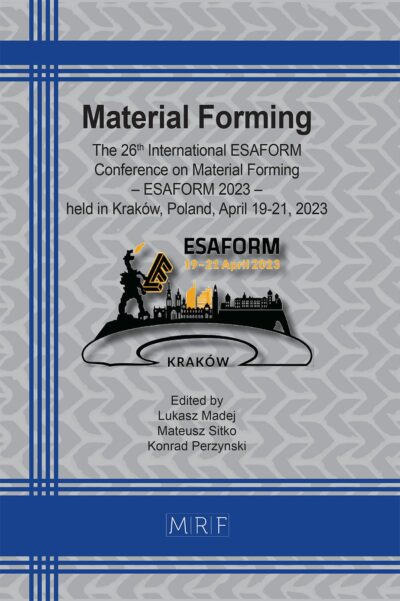Observation for the High-Speed Oblique Collision of Metals
Akihisa Mori, Shigeru Tanaka, Kazuyuki Hokamoto
download PDFAbstract. In explosive welding, it is known well that the collision angle and collision velocity are the important parameters to achieve good welding. In addition, generations of a metal jet and the interfacial waves are important for the explosive welding conditions. To know the parameters and the collision conditions, the optical observation and the numerical simulation for the oblique collision using a powder gun were done by the authors. A metal jet was observed clearly by using a powder gun and wavy interface was generated without the intermetallic layer for the reactive materials by controlling the welding conditions. In this investigation, the results of the optical observations and the numerical analysis for similar and dissimilar material combinations were reported.
Keywords
Oblique Collision, Explosive Welding, Interfacial Waves, Metal Jet, Numerical Simulation
Published online 7/30/2019, 5 pages
Copyright © 2019 by the author(s)
Published under license by Materials Research Forum LLC., Millersville PA, USA
Citation: Akihisa Mori, Shigeru Tanaka, Kazuyuki Hokamoto, Observation for the High-Speed Oblique Collision of Metals, Materials Research Proceedings, Vol. 13, pp 74-78, 2019
DOI: https://doi.org/10.21741/9781644900338-13
The article was published as article 13 of the book Explosion Shock Waves and High Strain Rate Phenomena
![]() Content from this work may be used under the terms of the Creative Commons Attribution 3.0 licence. Any further distribution of this work must maintain attribution to the author(s) and the title of the work, journal citation and DOI.
Content from this work may be used under the terms of the Creative Commons Attribution 3.0 licence. Any further distribution of this work must maintain attribution to the author(s) and the title of the work, journal citation and DOI.
References
[1] B. Crossland, Explosive Welding of Metals and its Application, Oxford University Press, 1982.
[2] M. A. Meyers, et al., Dynamic behavior of materials, John Wiley & Sons, 1994.
[3] C. Chemin, T. Qingming, Mechanism of Wave Formation at the Interface in Explosive Welding, Acta Mechanica Sinica, 5-2 (1989), 97-108. https://doi.org/10.1007/bf02489134
[4] S. Kakizaki, M. Watanabe and S. Kumai, Simulation and Experimental Analysis of Metal Jet Emission and Weld Interface Morphology in Impact Welding, Materials Trans., 52-5 (2011), 1003-1008. https://doi.org/10.2320/matertrans.l-mz201128
[5] G.R. Cowan, A.H. Holtman, Flow Configurations in Colliding Plates: Explosive Bonding, J. Appl. Phys., 34-4 (1963), 928-939. https://doi.org/10.1063/1.1729565
[6] T. Onzawa, Y. Ishii, Fundamental Studies on Explosive Welding, Trans. Japan Welding Society, 6-2 (1975), 98-104.
[7] R.H. Wittman, The Influence of Collision Parameters on the Strength and Microstructure of an Explosion Welded Aluminum Alloy, Proc. 2nd Sym. on Use of Explosive Energy in Manufacturing Metallic Materials of New Properties and Possibilities of Application thereof in the Chemical Industry, (1973), 153-168.
[8] A.A. Deribas, V.A. Simonov, and I.D. Zakcharenko, Investigation of Explosive Welding Parameters for Arbitrary Combinations of Metals and Alloys, Proc. 5th Int. Conf. on High Energy Rate Fabrication, (1975),4.1.1-4.1.24.
[9] Ulacia, I., Salisbury, C. P., Hurtado, I., Worswick, M. J., Tensile characterization and constitutive modeling of AZ31B magnesium alloy sheet over wide range of strain rates and temperatures, J. Mater. Process. Technol., 211(5), 830-839 (2011). https://doi.org/10.1016/j.jmatprotec.2010.09.010
[10] A. Mori, S. Tanaka, and K. Hokamoto, Optical observation of metal jet generated by high speed inclined collision, Proc. SPIE 10328, (2017), 103281Q. https://doi.org/10.1117/12.2270473














